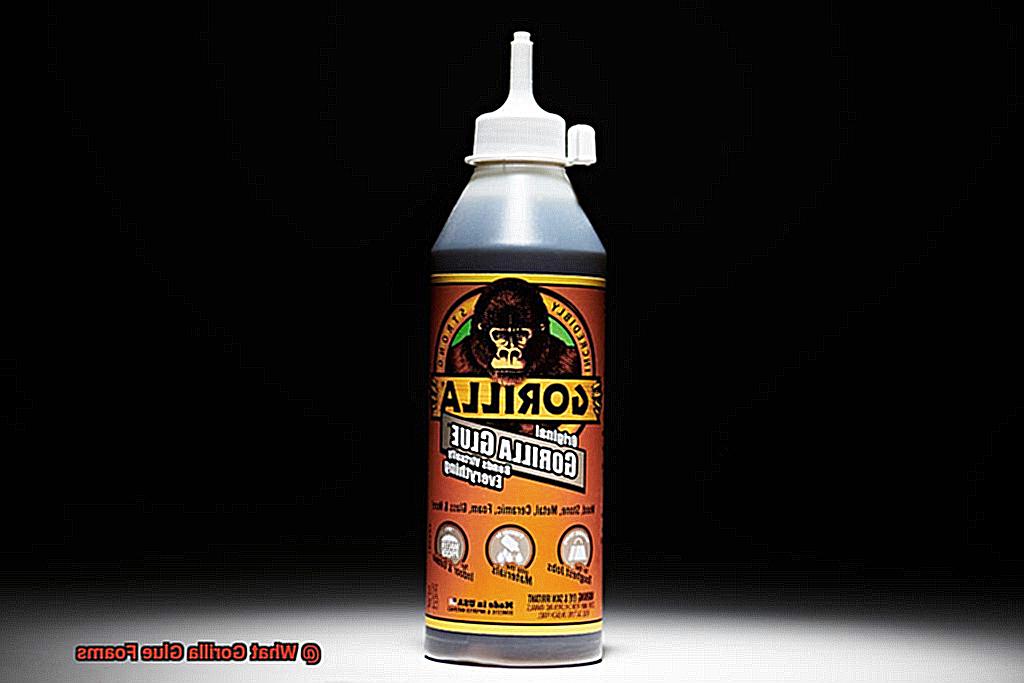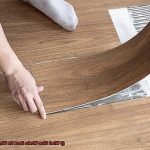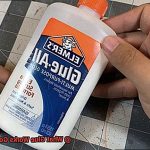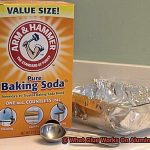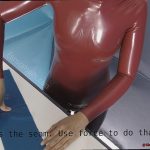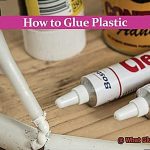Tired of those so-called “super glues” that never quite live up to their hype?
Well, get ready to meet your new DIY best friend: Gorilla Glue foam. This stuff is no ordinary adhesive.
It’s a game-changer, a revolutionary solution that will take your fix-it projects to a whole new level. With its unrivaled strength and versatility, Gorilla Glue foam expands as it dries, forming an unbreakable bond that can stand the test of time.
So grab your trusty toolbelt and wave goodbye to weak glues – because once you try Gorilla Glue foam, there’s no going back.

How Does Gorilla Glue Foam?
Contents
- 1 How Does Gorilla Glue Foam?
- 2 Benefits of the Foaming Properties of Gorilla Glue
- 3 Penetrating Porous Surfaces
- 4 Evenly Distributing Adhesive Across a Surface
- 5 Shock Absorption and Flexibility
- 6 Excessive Foaming Can Lead to Messy Overflow
- 7 Drying Time for Gorilla Glue
- 8 Using Gorilla Glue Sparingly
- 9 Conclusion
Gorilla Glue is a versatile adhesive known for its exceptional strength and unique foaming action. In this article, we will explore the science behind how Gorilla Glue foams up and why it is so effective at bonding various materials together.
The Chemical Reaction:
Gorilla Glue’s foaming mechanism is triggered by a chemical reaction between the glue’s polyurethane resin and moisture. Whether it’s water or humidity in the air, when the glue comes into contact with moisture, a transformation occurs that results in both a strong bond and an expansion in volume.
Filling Gaps and Enhancing Bond Strength:
When Gorilla Glue is applied to a surface, the presence of moisture initiates the chemical reaction within the glue. As the glue cures, it begins to foam up and expand, filling any gaps or voids between the surfaces being bonded. This expansion allows the glue to create a tight and secure bond by penetrating into crevices and irregularities in the materials.
The Benefits of Foaming:
Gorilla Glue’s foam offers several advantages in bonding applications. Firstly, it improves bond strength by ensuring maximum contact between the adhesive and the surfaces being joined. The expanded foam pushes against the surfaces, increasing the adhesive area and enhancing the overall strength of the bond.
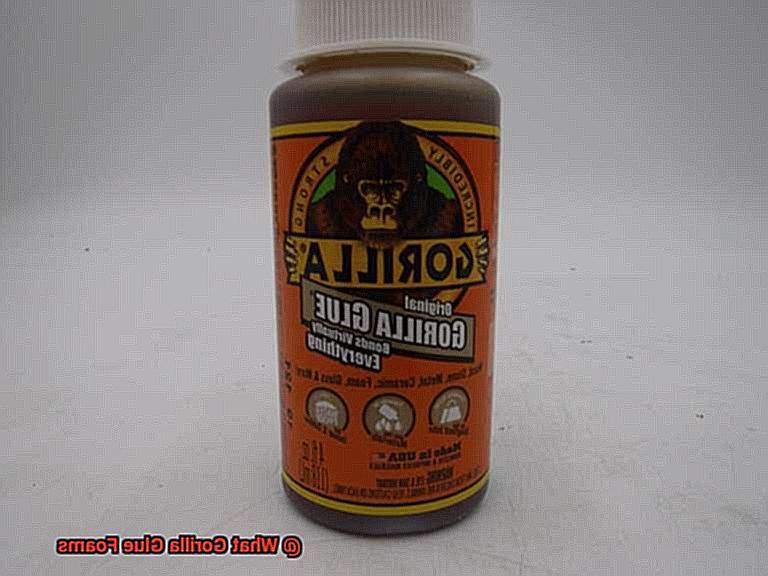
Furthermore, Gorilla Glue’s foam acts as a gap filler, making it ideal for bonding uneven or irregular surfaces. It can fill in gaps, cracks, and voids that may compromise the bond strength if left unfilled. The expanded foam also provides some degree of cushioning and flexibility, allowing for slight movements or vibrations without causing the bond to break.
Usage Considerations:
While Gorilla Glue’s foaming action is advantageous in many applications, there are a few key points to keep in mind. Firstly, the expansion of the glue can be significant, so it’s crucial to use it sparingly and apply only a thin layer. Applying too much glue can lead to excessive foaming, potentially causing the glue to overflow or create unwanted messes.
Additionally, Gorilla Glue’s foaming action requires the presence of moisture to initiate the chemical reaction. If the surfaces being bonded are dry or lack sufficient moisture, the glue may not foam up or cure properly. To ensure optimal bonding and foaming, it is advisable to dampen the surfaces slightly before applying the glue.
Benefits of the Foaming Properties of Gorilla Glue
Gorilla Glue’s foaming properties make it a must-have adhesive for all your bonding needs. When applied, this incredible glue expands and creates a foam-like structure, filling in any gaps or irregularities in the surface. Say goodbye to uneven surfaces that can make bonding a nightmare.
But the benefits don’t stop there. The foam created by Gorilla Glue also acts as an insulating barrier, helping to keep heat where it belongs and blocking out unwanted noise. Whether you’re working on a construction project or fixing up your car, Gorilla Glue has got you covered.
Water resistance is another major advantage of Gorilla Glue’s foaming properties. The expanding foam fills any gaps or cracks, preventing water from seeping through and ruining your hard work. No more worries about sudden downpours ruining your hours of effort.
The foaming action of Gorilla Glue also makes application a breeze. It expands slowly after being applied, giving you ample time to adjust and position your materials just right. No more rushed glue jobs that end in disaster.
And here’s an added bonus – because of its expanding nature, you actually need less glue for each application. That means you’re getting more bang for your buck and saving money in the process. Who doesn’t love that?
Lastly, let’s talk versatility. Gorilla Glue’s foaming properties make it suitable for a wide range of applications. Whether you’re a woodworking enthusiast, a DIY junkie, or a professional in the construction industry, this glue has got your back.
Penetrating Porous Surfaces
Penetrating porous surfaces is a fascinating feat, and Gorilla Glue is the superhero adhesive that can accomplish it with its incredible foaming action. When Gorilla Glue encounters a porous surface like wood, fabric, or paper, a chemical reaction is triggered, unleashing its foaming power. This unique characteristic sets Gorilla Glue apart from other glues on the market.
So, what makes this foaming action so crucial? Imagine working on a project with uneven or rough surfaces. No need to worry. Gorilla Glue’s foam rushes in to fill in those gaps and voids, ensuring a strong and secure bond. It acts as a trusty sidekick, evening out all the imperfections.
But that’s not all. The foam created by Gorilla Glue also enhances the overall bond strength. How does it achieve this? As the glue expands and fills the gaps, it creates more contact points between the adhesive and the material being bonded. And more contact points mean a stronger bond. It’s like adding reinforcements to your project, making it super sturdy and reliable.
However, it’s essential to note that not all surfaces are suitable for Gorilla Glue’s foaming action. Non-porous materials like glass or metal won’t allow for the expansion and foaming process to occur. In such cases, it’s necessary to opt for a different type of adhesive.
When using Gorilla Glue on porous surfaces, remember to apply it sparingly. The foam expands significantly during the process, so using too much can result in messy overflow. A thin layer of glue is all you need to embark on this foaming adventure.
And before you begin, make sure your surfaces are clean and free from any dirt, grease, or moisture. These sneaky contaminants can hinder the bonding process and affect the effectiveness of the foam. So, give your project a thorough cleaning to ensure a successful bond.
To summarize, Gorilla Glue’s foaming action is like having a superhero by your side when working with porous materials. It fills gaps, conforms to uneven surfaces, and increases bond strength like nobody’s business. By understanding how Gorilla Glue foams and using it correctly, you’ll achieve strong and reliable bonds on all your porous projects.
Evenly Distributing Adhesive Across a Surface
Let’s delve into the secrets of this art and discover how to master it like a pro.
The first step in this adhesive adventure is selecting the perfect applicator. With options ranging from brushes to rollers and spreaders, choosing the right tool is critical. Consider the nature of the surface you’re working on and the type of glue you’ll be using, and make a match that will ensure optimal distribution.
But before you dive headfirst into applying adhesive, it’s essential to prepare the surface like a seasoned pro. A thorough cleaning removes any dirt, dust, or grease that could compromise the bond. And if you’re feeling adventurous, give the surface some rough love with sanding or an abrasive material. This creates more surface area for the glue to cling onto, resulting in an extra-strong connection.
Now comes the exciting part – actually applying the adhesive. Pay close attention to the manufacturer’s instructions, especially if you’re working with foaming adhesives like Gorilla Glue. These magical glues love to expand as they cure, so a light touch is all you need. Remember, less is more when it comes to foaming adhesives.
When it comes to spreading the glue, different techniques work best for different projects. For large surfaces, embrace the back-and-forth motion with your applicator of choice – whether it’s a brush or roller – to achieve an even layer. If you’re dealing with smaller areas, unleash your finesse with a delicate touch using a small brush or spatula.
To avoid any adhesive mishaps along the way, consider working in sections. This not only helps you maintain control over the distribution process but also ensures that your glue doesn’t dry out before you can spread it evenly. Take your time, and savor the journey.
Last but not least, don’t forget about removing any excess adhesive. Nobody wants unsightly bumps and drips ruining their masterpiece. Arm yourself with a clean cloth or scraper, and gently remove any excess glue while being careful not to disturb the even distribution on the surface.
Shock Absorption and Flexibility
This unique glue is known for its foaming action, which contributes to its exceptional properties. Let’s dive in and unravel the secrets.
- Foaming Action: The foaming action of Gorilla Glue is more than just a visual spectacle. When applied to a surface, the glue undergoes a chemical reaction with moisture, causing it to expand and foam up. This expansion fills every nook and cranny, creating a tight bond that ensures secure connections.
- Enhanced Bond Strength: The expanding foam maximizes contact between the glue and the surfaces it bonds. It seeps into tiny crevices and irregularities, acting as a matchmaker for your materials. With Gorilla Glue, your project will stick together for life.
- Shock Absorption: Picture this – you drop your precious glued creation. Luckily, Gorilla Glue’s foaming action comes to the rescue. The foam compresses upon impact, absorbing some of the energy and reducing the risk of damage or breakage. It’s like having a cushioning superhero protecting your project.
- Flexibility: Gorilla Glue’s foam remains flexible even after it has fully cured. This means your bonded materials can move and expand without compromising the bond’s integrity. It’s like giving your project the freedom to dance and groove without missing a beat.
- Applications: Gorilla Glue’s shock absorption and flexibility properties make it a go-to choice for woodworking projects. It provides secure bonding and protects against impacts or vibrations. Additionally, the expanding foam fills gaps or voids, creating a seamless and solid bond.
- Cautionary Note: While Gorilla Glue’s foaming action is fantastic, excessive expansion can occur if not used properly. Follow the manufacturer’s instructions and use it in a well-ventilated area to avoid any foamy mishaps.
Excessive Foaming Can Lead to Messy Overflow
Today, we embark on a sticky journey into the world of Gorilla Glue, where we’ll explore a common conundrum: excessive foaming leading to messy overflow. So strap on your safety goggles and prepare for an adhesive adventure.
We all know Gorilla Glue is a formidable force when it comes to bonding materials together. Its unparalleled adhesive properties make it a go-to choice for many DIY projects. However, what sets Gorilla Glue apart from the rest is its remarkable ability to foam up upon contact with moisture. This foaming action is triggered by a chemical reaction between the glue and water molecules.
Now, brace yourselves for the potential mess if you’re not careful. Excessive foaming can occur when an abundance of glue is applied or when you find yourself working in a high-moisture environment. And let me tell you, when that foam starts expanding, it can lead to overflow that drips onto surfaces, leaving behind unsightly stains and creating quite the predicament.
But don’t fret, my fellow glue aficionados. There are simple steps you can take to prevent this foamy catastrophe. First and foremost, always exercise moderation when using Gorilla Glue and adhere to the instructions provided. Applying a thin layer of glue will help control the foaming action. Moreover, if you’re working with large or heavy materials, employing clamps or weights to secure them while the glue cures can help maintain order and prevent overflow.
Speaking of curing, it’s crucial to note that as the foam cures, it expands in size. Therefore, it is imperative to work in a well-ventilated area, allowing any excess moisture to evaporate. This preemptive measure will deter overflow mishaps from occurring in the first place.
However, let’s say disaster strikes and overflow happens despite your best efforts. Fear not. Grab a damp cloth and promptly wipe away the excess foam before it fully cures. In the event that dried foam residue persists, a bit of sanding or scraping may be required to restore surfaces to their former glory.
So there you have it, my friends. While foaming can undoubtedly be advantageous when using Gorilla Glue, it’s crucial to be cognizant of the potential for messy overflow. By exercising moderation, following instructions, and taking precautions in high-moisture environments, you can skillfully navigate around any sticky situations, ensuring your projects maintain a clean and professional appearance.
Drying Time for Gorilla Glue
This remarkable glue sets itself apart with its foaming action, expanding and filling gaps to create an even stronger bond between surfaces.
When it comes to drying time, several factors come into play. Temperature plays a significant role, with Gorilla Glue typically taking 24 hours to fully cure and reach maximum strength. However, colder temperatures can extend the drying time, so it’s best to work in a warm environment.
Humidity also affects drying time. Higher humidity levels slow down the process, while lower levels speed it up. Additionally, the amount of glue applied matters. Applying too much glue can prolong drying time, so following the manufacturer’s instructions is crucial.
To ensure a secure bond, it’s recommended to clamp or hold the glued surfaces together for at least two hours. This allows the glue enough time to set and create a strong connection.
Keep in mind that porous materials may require longer drying times. Patience is key when working with such materials.
Ultimately, always refer to the manufacturer’s instructions for precise drying times and application guidelines. Adhering to these instructions guarantees optimal results for your Gorilla Glue project.
Using Gorilla Glue Sparingly
Gorilla Glue is a legendary adhesive known for its unrivaled bonding capabilities. However, much like a superhero, it must be used wisely and sparingly to achieve optimal results. In this article, we will delve into the importance of using Gorilla Glue sparingly and provide you with step-by-step guidance on how to master its application.
Why Use Gorilla Glue Sparingly?
Using Gorilla Glue sparingly offers several advantages:
- Maximizes coverage: Gorilla Glue possesses unique foaming properties that allow a small amount to expand and cover a larger surface area. By using it sparingly, you can achieve extensive coverage without wasting excess glue.
- Prevents messiness: Applying too much Gorilla Glue can lead to excessive foaming, resulting in messy and challenging cleanup situations. Using the right amount ensures a clean and efficient application process.
Steps to Use Gorilla Glue Sparingly:
- Prepare the surface: Before applying the glue, lightly dampen the surface with water. This activates the adhesive and aids in the curing process.
- Apply a thin bead or line: Squeeze a small amount of Gorilla Glue onto one surface. A thin bead or line of glue is usually sufficient for most applications.
- Spread evenly: Use a brush or disposable applicator to spread the glue evenly across the surface. Work quickly but carefully, as the glue starts to foam and expand within minutes.
- Secure the bond: Clamp or hold the glued surfaces firmly in place until the adhesive sets. This ensures a tight bond and prevents any movement that may hinder proper adhesion.
- Trim excess foam (optional): Once the glue has fully cured, excess foam can be trimmed or sanded away if desired. However, excessive sanding should be avoided as it may weaken the bond.
Storage Tips:
To maintain the effectiveness of your Gorilla Glue:
- Keep the bottle tightly sealed: Prevent moisture from entering and activating the adhesive prematurely by ensuring the bottle is tightly sealed.
- Store in a cool, dry place: Maintain the potency of Gorilla Glue by storing it in a cool, dry place away from direct sunlight.
wXumpmwr8_M” >
Conclusion
In conclusion, Gorilla Glue foam is a revolutionary adhesive that is changing the game. Its foaming action sets it apart from all other glues on the market, making it the ultimate choice for both DIY enthusiasts and professionals.
The magic behind Gorilla Glue’s foam lies in its chemical reaction. When its polyurethane resin comes into contact with moisture, it triggers a remarkable expansion that fills gaps and voids like no other glue can. This not only enhances bond strength but also creates an incredibly secure connection between surfaces. Additionally, the foam acts as a gap filler, making it perfect for bonding even the most uneven or irregular surfaces.
The benefits of Gorilla Glue foam are countless. It maximizes contact between the adhesive and the materials being joined, resulting in unmatched bond strength. The foam also provides shock absorption and flexibility, allowing bonded materials to move freely without compromising the integrity of the bond. And let’s not forget about its insulating properties – this glue’s foam acts as a barrier against unwanted noise and offers impressive water resistance.
When using Gorilla Glue foam, remember to apply it sparingly to avoid excessive foaming and messy overflow. Following the manufacturer’s instructions and working in a well-ventilated area are crucial for successful applications.
Overall, Gorilla Glue foam is an adhesive powerhouse that delivers unbeatable strength and versatility. Whether you’re tackling woodworking projects or fixing household items, this glue will take your creations to new heights with its incredible foaming properties.

